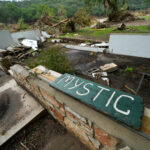The 2005 hurricane season’s record-setting $40 billion in claims underscores the need for reform in order to keep insurance coverage available and affordable in coastal areas, according to insurance executives at CSC Future Focus, a two-day conference hosted by Computer Sciences Corporation recently.
More than 100 insurance and risk management executives and industry analysts attended the third annual conference in Charleston, S.C. In the midst of the worst Atlantic hurricane season on record, conference speakers warned that catastrophic losses will continue to escalate unless the insurance industry works with state and federal governments to enforce building codes and reform land use regulations. Hurricane Katrina — the worst U.S. natural disaster — alone has generated an estimated $34.4 billion in insured losses.
“Experts predict that this type of hurricane season will be the norm for the next two decades, and rather than sustaining more losses, insurers are looking at the Gulf Coast and deciding not to do business there, or at least limit the amount of business they do,” Joseph Annotti, senior vice president of Public Affairs for the Property Casualty Insurers Association of America, told executives at Future Focus. “The government is sending $200 billion in tax money to New Orleans and the Gulf Coast, but are we going to rebuild in the same areas that were under water? Let’s at least rebuild to a certain standard for wind-resistant, flood-resistant homes. We need to go state-by-state to make sure we avoid the mistakes of the past.”
Annotti urged conference attendees to help the insurance industry reach a consensus on the best way to work with state and federal governments as they pay for catastrophic losses. Proposals included the creation of a national catastrophe fund, an amendment to the tax code to allow tax deferrals on insurance reserves and the funding of a government-backed reinsurance program.
“With more than 50 percent of people living in coastal areas, we have created a huge exposure to losses from mega catastrophes such as Katrina,” said Future Focus panelist William Mullaney, president of Personal Lines for MetLife Auto & Home. “It truly is a national issue that needs to be discussed. Through a combination of loss mitigation efforts, state catastrophe funds modeled after the Florida Hurricane Catastrophe Fund or the California Earthquake Authority, and potentially a national catastrophic loss fund, we can develop a more comprehensive approach to addressing these risks.”
Unprecedented growth in Southeastern states is driving up demand for homeowners’ insurance in areas prone to wind damage and flooding. That growth, combined with four hurricanes in Florida in 2004, generated 1.6 million claims — 97 percent of which were paid within 39 days.
“Florida is a great place to live as long as the wind isn’t blowing, but it can be a tough place to do business,” remarked William Sanders, president of Florida-based Vanguard Fire & Casualty and a Future Focus panelist. “In three counties in central Florida, 30,000 new homes were built each year over the past three years, and home values are climbing even faster. The same thing is happening in California, where earthquakes are a big risk. We need to decide how we as a country are going to deal with this exposure.”
The impact of Hurricane Katrina on communications and the inability to access damaged areas in New Orleans during and after the disaster are also prompting insurers to rethink the way they prepare for catastrophes.
“Our current plans assume our people would be available to perform the tasks needed for recovery, but as we saw with police and emergency crews after Katrina, those resources might not be available because they were also personally impacted,” said Alan Mercaldo, vice president and chief information officer of MAG Mutual Insurance. “In the future, we need to consider outsourcing options to supplement those resources, the staging of equipment at another location and preparing for an alternative communications infrastructure, such as wireless technology.”
In addition to panel discussions, the conference featured 14 sessions on issues including insurance commission investigations, voice over IP, claims automation, computer hacking and identity theft fraud. Presenters included analysts from research and advisory firms Datamonitor, TowerGroup and Celent Communications.
Was this article valuable?
Here are more articles you may enjoy.

 Poorer Americans Dropped Federal Flood Insurance When Rates Rose
Poorer Americans Dropped Federal Flood Insurance When Rates Rose  Texas Camp’s Reopening Draws Outrage, but Some Families Want to Return
Texas Camp’s Reopening Draws Outrage, but Some Families Want to Return  Marijuana’s Move to Schedule III: What it Really Means for Cannabis Insurance
Marijuana’s Move to Schedule III: What it Really Means for Cannabis Insurance  Waymo to Update Software Across Fleet After Major Power Failure
Waymo to Update Software Across Fleet After Major Power Failure 